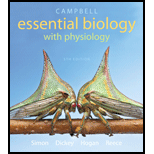
Campbell Essential Biology with Physiology (5th Edition)
5th Edition
ISBN: 9780321967671
Author: Eric J. Simon, Jean L. Dickey, Jane B. Reece, Kelly A. Hogan
Publisher: PEARSON
expand_more
expand_more
format_list_bulleted
Concept explainers
Question
Chapter 27, Problem 6SQ
Summary Introduction
To explain: How a person can be able to live in a nonresponsive state in which the cerebral cortex is damaged.
Concept introduction:
Human brain consists of up to 100 billion complicatedly organized neurons. Anatomically, the brain consists of three major parts namely the forebrain, midbrain, and hind brain. The mid brain, pons, and medulla oblongata are together called as the brain stem.
Expert Solution & Answer
Want to see the full answer?
Check out a sample textbook solution
Students have asked these similar questions
Say you get AATTGGCAATTGGCAATTGGCAATTGGCAATTGGCAATTGGCAATTGGC 3ʹ and it is cleaved with Mspl restriction enzyme - how do I find how many fragments?
What is amplification bias?
What would happen if transcriptome analysis were done on liver and muscle cells?
Chapter 27 Solutions
Campbell Essential Biology with Physiology (5th Edition)
Ch. 27 - A neuron ends in many branches, each with a...Ch. 27 - Prob. 2SQCh. 27 - Your nervous system can be divided into two broad...Ch. 27 - Prob. 4SQCh. 27 - Prob. 5SQCh. 27 - Prob. 6SQCh. 27 - How is an action potential different from a...Ch. 27 - For each of the following senses in humans,...Ch. 27 - Mr. Johnson is becoming slightly deaf. To test his...Ch. 27 - Prob. 10SQ
Knowledge Booster
Learn more about
Need a deep-dive on the concept behind this application? Look no further. Learn more about this topic, biology and related others by exploring similar questions and additional content below.Similar questions
- Biology How many grams of sucrose would you add to 100mL of water to make a 100 mL of 5% (w/v) sucrosesolution?arrow_forwardWhich marker does this DNA 5ʹ AATTGGCAATTGGCAATTGGCAATTGGCAATTGGCAATTGGCAATTGGC 3ʹ show?arrow_forwardThe Z value of LOD for two genes is 4, what does it mean for linkage and inheritance?arrow_forward
- Biology How will you make a 50-ul reaction mixture with 2uM primer DNA using 10 uM primer DNA stocksolution and water?arrow_forwardBiology You’re going to make 1% (w/v) agarose gel in 0.5XTBE buffer 100 ml. How much agarose are you goingto add to 100 ml of buffer? The volume of agaroseis negligible.arrow_forwardBiology How will you make a 50-ul reaction mixture with0.2 mM dNTP using 2-mM dNTP stock solution andwater?arrow_forward
- Biology What is 200 pmole/uL in Molar concentration?arrow_forwardBiology How will you make a 50-ul reaction mixture with 1Xreaction buffer in it using water and 5X buffer stocksolution?arrow_forwardBiology How would you make 200 uL of 10 pmole/uLprimer DNA solution using the 200 pmole/uLprimer DNA stock solution and distilled water?arrow_forward
- Biology Now you have the 5 M of NaCl stock solution. Howwould you make one liter of 100 mM NaCl solutionusing the 5 M of NaCl solution and distilled water?arrow_forwardDevelopmental Biology Lab Question How to make one liter of 5 M NaCl stock solution?The molar weight of NaCl is 58.44 g/mol.(Molecular weight is 58.44 Dalton or amu).arrow_forwardDevelopmental Biology What is the definition of 1 M? (in the context of stock and dilutions)arrow_forward
arrow_back_ios
SEE MORE QUESTIONS
arrow_forward_ios
Recommended textbooks for you
 Human Biology (MindTap Course List)BiologyISBN:9781305112100Author:Cecie Starr, Beverly McMillanPublisher:Cengage Learning
Human Biology (MindTap Course List)BiologyISBN:9781305112100Author:Cecie Starr, Beverly McMillanPublisher:Cengage Learning




Human Biology (MindTap Course List)
Biology
ISBN:9781305112100
Author:Cecie Starr, Beverly McMillan
Publisher:Cengage Learning

